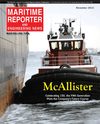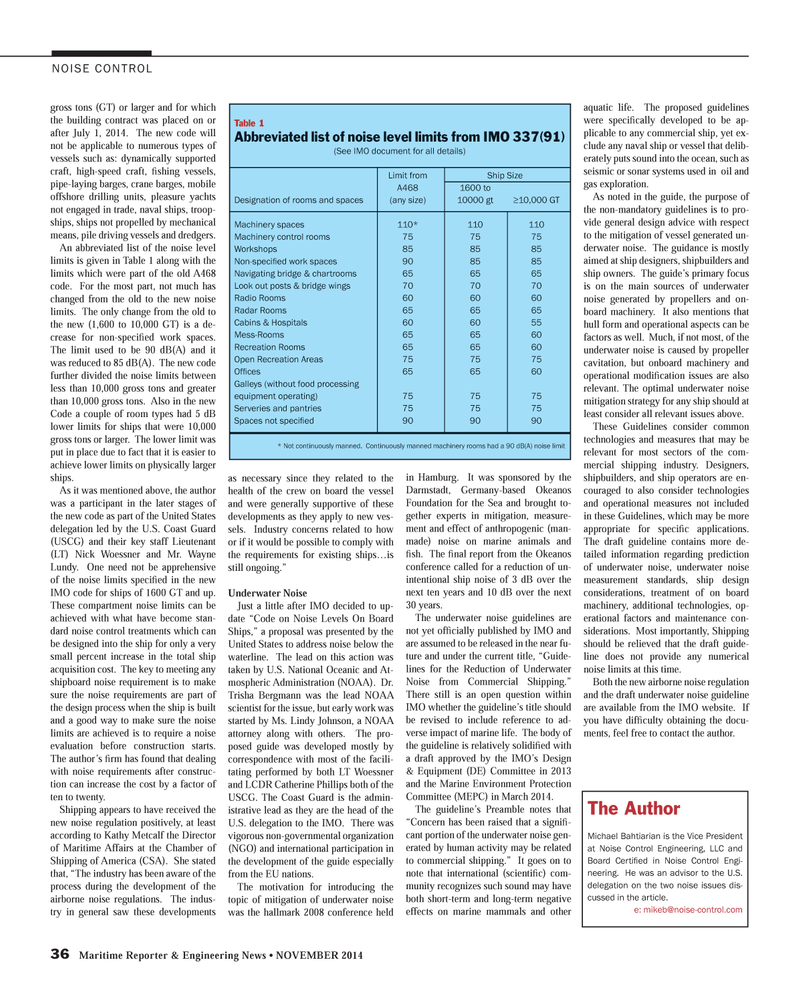
Page 36: of Maritime Reporter Magazine (November 2014)
Workboat Edition
Read this page in Pdf, Flash or Html5 edition of November 2014 Maritime Reporter Magazine
36 Maritime Reporter & Engineering News • NOVEMBER 2014
NOISE CONTROL gross tons (GT) or larger and for which the building contract was placed on or after July 1, 2014. The new code will not be applicable to numerous types of vessels such as: dynamically supported craft, high-speed craft, ? shing vessels, pipe-laying barges, crane barges, mobile offshore drilling units, pleasure yachts not engaged in trade, naval ships, troop- ships, ships not propelled by mechanical means, pile driving vessels and dredgers.
An abbreviated list of the noise level limits is given in Table 1 along with the limits which were part of the old A468 code. For the most part, not much has changed from the old to the new noise limits. The only change from the old to the new (1,600 to 10,000 GT) is a de- crease for non-speci? ed work spaces.
The limit used to be 90 dB(A) and it was reduced to 85 dB(A). The new code further divided the noise limits between less than 10,000 gross tons and greater than 10,000 gross tons. Also in the new
Code a couple of room types had 5 dB lower limits for ships that were 10,000 gross tons or larger. The lower limit was put in place due to fact that it is easier to achieve lower limits on physically larger ships.
As it was mentioned above, the author was a participant in the later stages of the new code as part of the United States delegation led by the U.S. Coast Guard (USCG) and their key staff Lieutenant (LT) Nick Woessner and Mr. Wayne
Lundy. One need not be apprehensive of the noise limits speci? ed in the new
IMO code for ships of 1600 GT and up.
These compartment noise limits can be achieved with what have become stan- dard noise control treatments which can be designed into the ship for only a very small percent increase in the total ship acquisition cost. The key to meeting any shipboard noise requirement is to make sure the noise requirements are part of the design process when the ship is built and a good way to make sure the noise limits are achieved is to require a noise evaluation before construction starts.
The author’s ? rm has found that dealing with noise requirements after construc- tion can increase the cost by a factor of ten to twenty.
Shipping appears to have received the new noise regulation positively, at least according to Kathy Metcalf the Director of Maritime Affairs at the Chamber of
Shipping of America (CSA). She stated that, “The industry has been aware of the process during the development of the airborne noise regulations. The indus- try in general saw these developments as necessary since they related to the health of the crew on board the vessel and were generally supportive of these developments as they apply to new ves- sels. Industry concerns related to how or if it would be possible to comply with the requirements for existing ships…is still ongoing.”
Underwater Noise
Just a little after IMO decided to up- date “Code on Noise Levels On Board
Ships,” a proposal was presented by the
United States to address noise below the waterline. The lead on this action was taken by U.S. National Oceanic and At- mospheric Administration (NOAA). Dr.
Trisha Bergmann was the lead NOAA scientist for the issue, but early work was started by Ms. Lindy Johnson, a NOAA attorney along with others. The pro- posed guide was developed mostly by correspondence with most of the facili- tating performed by both LT Woessner and LCDR Catherine Phillips both of the
USCG. The Coast Guard is the admin- istrative lead as they are the head of the
U.S. delegation to the IMO. There was vigorous non-governmental organization (NGO) and international participation in the development of the guide especially from the EU nations.
The motivation for introducing the topic of mitigation of underwater noise was the hallmark 2008 conference held in Hamburg. It was sponsored by the
Darmstadt, Germany-based Okeanos
Foundation for the Sea and brought to- gether experts in mitigation, measure- ment and effect of anthropogenic (man- made) noise on marine animals and ? sh. The ? nal report from the Okeanos conference called for a reduction of un- intentional ship noise of 3 dB over the next ten years and 10 dB over the next 30 years.
The underwater noise guidelines are not yet of? cially published by IMO and are assumed to be released in the near fu- ture and under the current title, “Guide- lines for the Reduction of Underwater
Noise from Commercial Shipping.”
There still is an open question within
IMO whether the guideline’s title should be revised to include reference to ad- verse impact of marine life. The body of the guideline is relatively solidi? ed with a draft approved by the IMO’s Design & Equipment (DE) Committee in 2013 and the Marine Environment Protection
Committee (MEPC) in March 2014.
The guideline’s Preamble notes that “Concern has been raised that a signi? - cant portion of the underwater noise gen- erated by human activity may be related to commercial shipping.” It goes on to note that international (scienti? c) com- munity recognizes such sound may have both short-term and long-term negative effects on marine mammals and other aquatic life. The proposed guidelines were speci? cally developed to be ap- plicable to any commercial ship, yet ex- clude any naval ship or vessel that delib- erately puts sound into the ocean, such as seismic or sonar systems used in oil and gas exploration.
As noted in the guide, the purpose of the non-mandatory guidelines is to pro- vide general design advice with respect to the mitigation of vessel generated un- derwater noise. The guidance is mostly aimed at ship designers, shipbuilders and ship owners. The guide’s primary focus is on the main sources of underwater noise generated by propellers and on- board machinery. It also mentions that hull form and operational aspects can be factors as well. Much, if not most, of the underwater noise is caused by propeller cavitation, but onboard machinery and operational modi? cation issues are also relevant. The optimal underwater noise mitigation strategy for any ship should at least consider all relevant issues above.
These Guidelines consider common technologies and measures that may be relevant for most sectors of the com- mercial shipping industry. Designers, shipbuilders, and ship operators are en- couraged to also consider technologies and operational measures not included in these Guidelines, which may be more appropriate for speci? c applications.
The draft guideline contains more de- tailed information regarding prediction of underwater noise, underwater noise measurement standards, ship design considerations, treatment of on board machinery, additional technologies, op- erational factors and maintenance con- siderations. Most importantly, Shipping should be relieved that the draft guide- line does not provide any numerical noise limits at this time.
Both the new airborne noise regulation and the draft underwater noise guideline are available from the IMO website. If you have dif? culty obtaining the docu- ments, feel free to contact the author.
The Author
Michael Bahtiarian is the Vice President at Noise Control Engineering, LLC and
Board Certifi ed in Noise Control Engi- neering. He was an advisor to the U.S. delegation on the two noise issues dis- cussed in the article. e: [email protected]
Table 1
Abbreviated list of noise level limits from IMO 337(91) (See IMO document for all details) Limit from Ship Size A468 1600 to
Designation of rooms and spaces (any size) 10000 gt =10,000 GT
Machinery spaces 110* 110 110
Machinery control rooms 75 75 75
Workshops 85 85 85
Non-specifi ed work spaces 90 85 85
Navigating bridge & chartrooms 65 65 65
Look out posts & bridge wings 70 70 70
Radio Rooms 60 60 60
Radar Rooms 65 65 65
Cabins & Hospitals 60 60 55
Mess-Rooms 65 65 60
Recreation Rooms 65 65 60
Open Recreation Areas 75 75 75
Offi ces 65 65 60
Galleys (without food processing equipment operating) 75 75 75
Serveries and pantries 75 75 75
Spaces not specifi ed 90 90 90 * Not continuously manned. Continuously manned machinery rooms had a 90 dB(A) noise limit
MR #11 (34-41).indd 36 10/23/2014 11:45:27 AM

 35
35

 37
37
